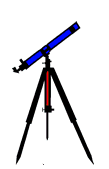Universe Cycle - The Search for Our Beginning
by J.R. Blueford Ph.D.
|
|
K
|
1
|
2
|
3
|
4
|
5
|
6
|
|
Universe
(1
week)
|
Comparing
Distance in Space
|
Light
in the Universe
|
Stars
and Constellations
|
Components
of Galaxies
|
Comparing
Galaxies
|
Components
of the Universe
|
Astronomy
and Astrology
|
|
Solar
System
(1
week)
|
Comparing
Planets
|
Surface
of the Moon
|
Identifying
Planets
|
Earth
Movements
|
Craters
|
Comparing
Planets
|
Movement
of the Earth
|
|
Earth
(1
week)
|
Modeling
the Earth
|
Rotation
of the Earth
|
Examining
the Earth's Surface
|
Comparing
Landforms
|
Earth/Moon
System
|
Forces
of Erosion
|
Landform
Evolution
|
|
Geography
(1 week)
|
Land
and Water
|
Learning
Geographic Relief
|
Making
Maps
|
Use
of Maps
|
Interpretations
of Maps
|
Mapping
Relief
|
Uses
of Maps
|
 The
Universe Cycle helps explain how the Universe and Solar System was formed.
Students learn that there are many theories on how the Universe was created.
Atoms of hydrogen (the simplest element) probably were floating around each
other, and they collided (either with a bang or a whimper) and formed stars.
Star formation led the way for planet formation probably by accretion. Our
planets formed to revolve around one star, the Sun. The characteristics of each
planet depend on how close they were to the Sun; how fast it spins; and how
their internal engines work.
The
Universe Cycle helps explain how the Universe and Solar System was formed.
Students learn that there are many theories on how the Universe was created.
Atoms of hydrogen (the simplest element) probably were floating around each
other, and they collided (either with a bang or a whimper) and formed stars.
Star formation led the way for planet formation probably by accretion. Our
planets formed to revolve around one star, the Sun. The characteristics of each
planet depend on how close they were to the Sun; how fast it spins; and how
their internal engines work.
Hands-on activities teach students about the facts and
fantasies of the Universe. They look at the Universe and its components of
galaxies and nebulas. Students then look at our Solar System. They trace
movements and compare and contrast the planets. The Earth is a planet as it
spins with its satellite, the Moon. Students will take a close look at the Earth
and its relationship within the Solar System. Geographic locations, reading maps
and learning how to plot data are also explored.
Universe - Students can look
up and realize that everything is called the Universe. The universe is not
understood, but is fascinating to think about.
Solar System - Students
learn that the solar system is a subset of the Universe and is part of our
Earthly history. They compare and contrast the planets and learn that we don't
know everything about our planets.
Earth - Allows students to
picture the Earth as a rotating and revolving sphere in space. Students will
realize that the Earth has unique features.
Geography - Although this is
not science, it provides that template which we record data from different
fields of science. Learning to locate oneself is a skill needed not only in
science but for general living.
Plate
Tectonics Cycle - Earth's Moving Force
 The
Universe Cycle helps explain how the Universe and Solar System was formed.
Students learn that there are many theories on how the Universe was created.
Atoms of hydrogen (the simplest element) probably were floating around each
other, and they collided (either with a bang or a whimper) and formed stars.
Star formation led the way for planet formation probably by accretion. Our
planets formed to revolve around one star, the Sun. The characteristics of each
planet depend on how close they were to the Sun; how fast it spins; and how
their internal engines work.
The
Universe Cycle helps explain how the Universe and Solar System was formed.
Students learn that there are many theories on how the Universe was created.
Atoms of hydrogen (the simplest element) probably were floating around each
other, and they collided (either with a bang or a whimper) and formed stars.
Star formation led the way for planet formation probably by accretion. Our
planets formed to revolve around one star, the Sun. The characteristics of each
planet depend on how close they were to the Sun; how fast it spins; and how
their internal engines work.